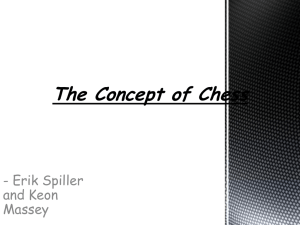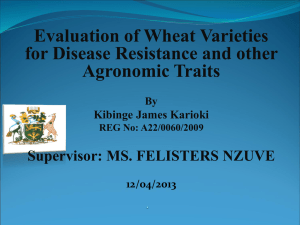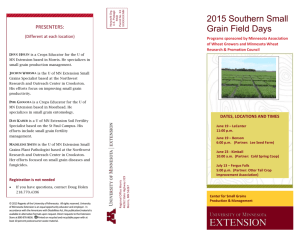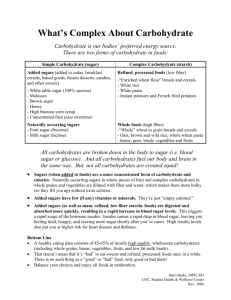PJZ-557-08 - Zoological Society Of Pakistan
advertisement
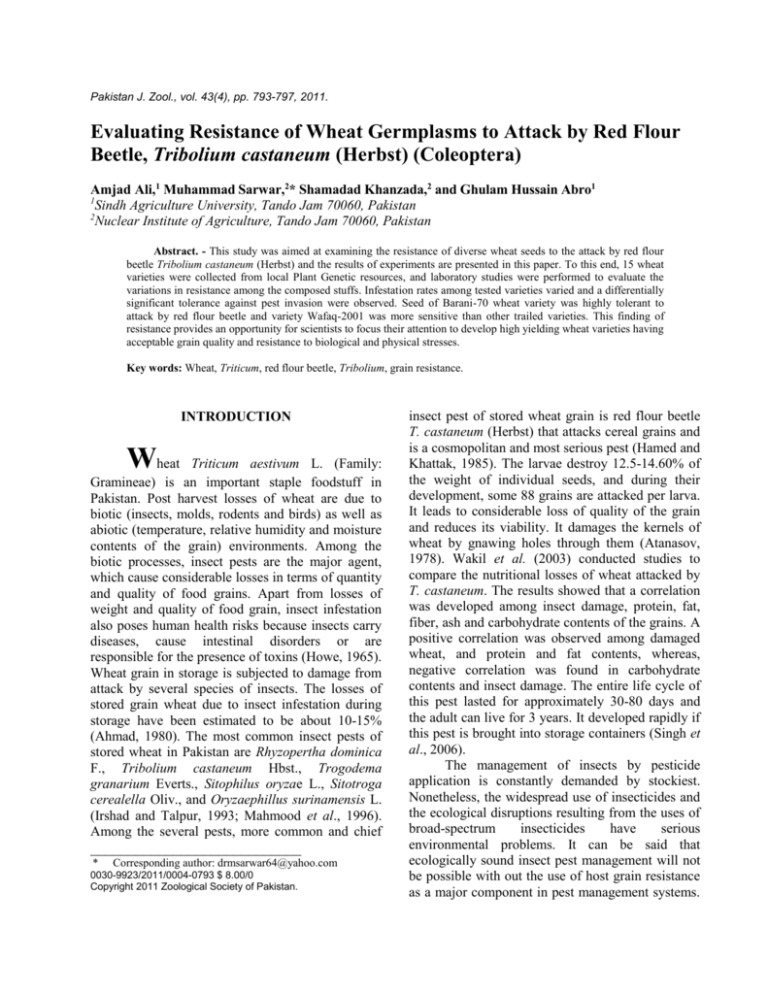
Pakistan J. Zool., vol. 43(4), pp. 793-797, 2011. Evaluating Resistance of Wheat Germplasms to Attack by Red Flour Beetle, Tribolium castaneum (Herbst) (Coleoptera) Amjad Ali,1 Muhammad Sarwar,2* Shamadad Khanzada,2 and Ghulam Hussain Abro1 1 Sindh Agriculture University, Tando Jam 70060, Pakistan 2 Nuclear Institute of Agriculture, Tando Jam 70060, Pakistan Abstract. - This study was aimed at examining the resistance of diverse wheat seeds to the attack by red flour beetle Tribolium castaneum (Herbst) and the results of experiments are presented in this paper. To this end, 15 wheat varieties were collected from local Plant Genetic resources, and laboratory studies were performed to evaluate the variations in resistance among the composed stuffs. Infestation rates among tested varieties varied and a differentially significant tolerance against pest invasion were observed. Seed of Barani-70 wheat variety was highly tolerant to attack by red flour beetle and variety Wafaq-2001 was more sensitive than other trailed varieties. This finding of resistance provides an opportunity for scientists to focus their attention to develop high yielding wheat varieties having acceptable grain quality and resistance to biological and physical stresses. Key words: Wheat, Triticum, red flour beetle, Tribolium, grain resistance. INTRODUCTION Wheat Triticum aestivum L. (Family: Gramineae) is an important staple foodstuff in Pakistan. Post harvest losses of wheat are due to biotic (insects, molds, rodents and birds) as well as abiotic (temperature, relative humidity and moisture contents of the grain) environments. Among the biotic processes, insect pests are the major agent, which cause considerable losses in terms of quantity and quality of food grains. Apart from losses of weight and quality of food grain, insect infestation also poses human health risks because insects carry diseases, cause intestinal disorders or are responsible for the presence of toxins (Howe, 1965). Wheat grain in storage is subjected to damage from attack by several species of insects. The losses of stored grain wheat due to insect infestation during storage have been estimated to be about 10-15% (Ahmad, 1980). The most common insect pests of stored wheat in Pakistan are Rhyzopertha dominica F., Tribolium castaneum Hbst., Trogodema granarium Everts., Sitophilus oryzae L., Sitotroga cerealella Oliv., and Oryzaephillus surinamensis L. (Irshad and Talpur, 1993; Mahmood et al., 1996). Among the several pests, more common and chief ____________________________ * Corresponding author: drmsarwar64@yahoo.com 0030-9923/2011/0004-0793 $ 8.00/0 Copyright 2011 Zoological Society of Pakistan. insect pest of stored wheat grain is red flour beetle T. castaneum (Herbst) that attacks cereal grains and is a cosmopolitan and most serious pest (Hamed and Khattak, 1985). The larvae destroy 12.5-14.60% of the weight of individual seeds, and during their development, some 88 grains are attacked per larva. It leads to considerable loss of quality of the grain and reduces its viability. It damages the kernels of wheat by gnawing holes through them (Atanasov, 1978). Wakil et al. (2003) conducted studies to compare the nutritional losses of wheat attacked by T. castaneum. The results showed that a correlation was developed among insect damage, protein, fat, fiber, ash and carbohydrate contents of the grains. A positive correlation was observed among damaged wheat, and protein and fat contents, whereas, negative correlation was found in carbohydrate contents and insect damage. The entire life cycle of this pest lasted for approximately 30-80 days and the adult can live for 3 years. It developed rapidly if this pest is brought into storage containers (Singh et al., 2006). The management of insects by pesticide application is constantly demanded by stockiest. Nonetheless, the widespread use of insecticides and the ecological disruptions resulting from the uses of broad-spectrum insecticides have serious environmental problems. It can be said that ecologically sound insect pest management will not be possible with out the use of host grain resistance as a major component in pest management systems. 794 A. ALI ET AL. This method of pest control may be profitable for growers, and they can reduce the overall threat that insects pose for agriculture. Our current efforts have been focused on the possibility of making use of host grain resistance to insects toward regulating pest populations as a preventative measure. As the investigations progress and with the promising results obtained, management by the release of tolerant wheat genotypes may be a more self-reliant and holistic approach to eliminate or maintain total insect pest populations below acceptable damage levels. MATERIALS AND METHODS Experiments on the population development of red flour beetle T. castaneum (Herbst) on miscellaneous wheat grains as food substrates were performed in the laboratory at the Department of Entomology, Sindh Agriculture University, Tandojam from 20 August 2004 to 20 January 2005. This allowed us to assess any resistance variability, which may have been attributable to genetic differences existing between varieties. The wheat varieties used in these experiments were about 4 months old. All experiments were conducted in a climate controlled room at 25°C, 70% R. H., and a photoperiod of 10: 14 (L: D) hours. The adults of red flour beetles were obtained from a stock, reared in the laboratory for 2 years. Newly emerged adult beetles were used in the no choice experiments. In this developmental stage, insects usually begin to disperse, which offered a higher mobility in the experiments. The tests were conducted by placing grain into glass cups topped with muslin handkerchief and secured with rubber bands. The standard weight of samples for each variety used in the experiment was 50 g, kept in glass containers (15 x 6 cm). Ten couples of newly emerged adults of flour beetles (both sexes into equivalent statistics) of homogeneous age from laboratory-stocked culture were released in the middle of each cup containing grain in each replicate. Adults were gently released in the test arena per treatment for oviposition; each treatment was replicated three times. These cups were positioned horizontally with a distance of 10 cm between the each one in the controlled environment room. During testing, observations were recorded on weekly basis to assess population growth of released insect by counting larvae, pupea, adults and mortality that had occurred. The numbers of adults in each test were counted and their mean proportion encountered was compared within each varieties. All varieties receiving feeding damage were compared using a similar procedure. Occurrence of other criterion such as total grains, healthy and damaged grains and percentage damage were recorded at the end of the experiment. For evaluating frass weight, the quantity of frass material within each treatment was separated, weighed and recorded. Similarly, the mean proportions of losses were compared between varieties to calculate significant differences between the treatments. Furthermore, the results obtained from the experiments were pooled and analyzed with an ANOVA, followed by Duncan multiple range test, when significance was demonstrated (P= 0.05). RESULTS AND DISCUSSION Results indicate that all wheat varieties wheat suffered losses. But the degree of susceptibility differed to a very large extent. A strong correlation existed between pest population and tolerance of seed. As insect population potential increased, rate of infestation also increased. On the basis of domino effect realized, it was possible to categorize the test genotypes into relatively resistant, moderately resistant, moderately susceptible as well as relatively susceptible. All tested varieties varied in the total number of grains present in 50g of each seed sample. Smallest total numbers of grains were counted in varieties Sonalika and Inqilab-91, where 1267 and 1288 grains were recorded in a 50g sample, respectively. Variety Barani-70 was third in grain number having 1382 grains per sample. The highest number of grains was observed in Saleem-2000 and Hyder-2000, where 2152 and 2019 grains were reckoned, respectively. Amongst other varieties, total number of grains ranged from 1423 to 1704 in each sample. Seeing that the different varieties exhibited variation in numbers of grain in each 50g sample, COMPLETED WHEAT GRAIN RESISTANCE TO RED FLOUR BEELTE Table I.S. # 1 2 3 4 5 6 7 8 9 10 11 12 13 14 15 795 Multiple comparison of infestation by red flour beetle on different wheat varieties. Varieties Wafaq-2001 Z. A-77 S.H-2003 Pir Sabak-91 Soghat-90 Hyder-2000 Bhittai Pak-81 Saleem-2000 Maxi Pak-65 Barani-83 Sonalika Inqilab-91 T. J-83 Barani-70 Total grains Healthy grains Damaged grains 1523 bc 1456 bc 1423 bc 1689 b 1552 bc 2019 a 1704 b 1627 b 2152 a 1568 bc 1480 bc 1267 c 1288 c 1580 bc 1382 c 1100 cd 1139 cd 1136 cd 1367 bcd 1245 cd 1665 ab 1419 bc 1409 bcd 1782 a 1355 bcd 1321 bcd 1030 d 1160 cd 1437 bc 1309 bcd 422.7 a 316.7 abc 287.3 abcde 322.3 abc 307.7 abcd 353.7 ab 283.3 abcde 217.3 bcdef 370.3 ab 213.3 bcdef 158.7 cdef 237.0 bcdef 127.7 ef 143.0 def 82.00 f Percent infestation 27.70 a 21.73 ab 20.52 abc 19.50 abc 19.84 abc 17.59 abc 16.62 abcd 14.60 bcd 17.18 abcd 12.76 bcd 10.82 bcd 18.60 abc 9.823 bcd 9.053 cd 5.720 d Frass weight 0.954 a 0.732 b 0.695 b 0.658 bc 0.671 b 0.546 de 0.522 def 0.518 def 0.545 de 0.463 efg 0.448 efg 0.568 cd 0.430 fg 0.412 g 0.306 h Adult population 92.00 a 78.00 ab 74.00 bc 69.33 bcd 70.67 bc 64.67 bcd 61.67 bcd 58.33 cde 63.67 bcd 52.00 def 43.67 efg 67.00 bcd 40.00 fg 39.00 fg 32.67 g Means of each variety sharing by the same letters in a column are not significantly different at P= 0.05. naturally there existed diversity in number of healthy grains at the end of exposure to infestation. In this respect the highest healthy grains 1782 and 1665 occurred in the varieties Saleem-2000 and Hyder-2000, on the other hand, at the bottom was variety Sonalika with 1030 grains. Number of healthy grains in other varieties varied from 1100 to 1437 per sample. For the parameter of number of grains attacked by pest, responses of all test varieties were also varied. The maximum damaged grains were observed in variety Wafaq-2001 with 422 infested grains. Variety Barani-70 was the least affected and flour beetle attacked only 82 grains. Similarly, the remaining varieties had moderate responses within tolerant and susceptible varieties, and the number of grains damaged ranged from 127 to 370. For number of grains damaged, variety Barani-70 behaved better than the remaining varieties, showing its tolerance, and Wafaq-2001 was most susceptible to pest attack. The results on % infestation are also presented in the same Table. The lowest % damage was also in variety Barani-70 showing 5.72% infestation and the highest in Wafaq-2001 at 27.70%; consequently both these varieties behaved most tolerant and susceptible responses, respectively. The other varieties showed moderate differences for this character, where the magnitudes of % damage ranged from 9.05% to 21.73%. Frass weight followed a similar trend in all the varieties as was observed in case of % infestation intensity. Maximum frass material was recorded in variety Wafaq-2001 with 0.954g followed by Z. A-77 (0.732g) and S. H-2003 (0.695g). The minimum frass material was found in variety Barani-70 having 0.306g outputs followed by T. J-83 with 0.412g weights obtained. These observations recorded clearly confirm that variety Barani-70 and Wafaq-2001 are most tolerant and susceptible to damage by red flour beetle. All the remaining varieties gave an idea that frass weight remained in the order of 0.430g upto 0.671g. Depending upon the varietals tolerance, all the trailed varieties differed in their ability to support a population of red flour beetle. The peak population build up recorded in variety Wafaq-2001 was 92 adults, while Z. A-77 and S. H-2003 were graded at second and third position with 78 and 74 insect, respectively. The lowest population emergence was counted in variety Barani-70 holding 32 adults, which was approached by T. J-83 and Inqilab-91 varieties where 39 and 40 adults were counted, correspondingly. All the remaining varieties averaged 70.67 to 43.67 adult emergences. It is evident from these results that varieties 796 A. ALI ET AL. tested had a range of resistance to flour beetle injury under laboratory conditions. The resistance cannot be attributed to size of grain, the significant differences observed among these wheat varieties for different parameters corroborate with the practical findings of Simwat and Chahal (1982), and Ramzan and Chahal (1986), where the extent of damage in different wheat varieties was reported to differ very much and some of wheat varieties were reported resistant to T. castaneum. But Singh et al. (1969) provided evidence that varieties of wheat could not express their resistance to insect injury. Results reported here on % infestation specified that the % damage ranged from 5.72% to 27.70% and is in accordance with the findings of Banerjee and Nazimuddin (1985) where it was concluded that simultaneous feeding by the adult’s species caused a maximum weight loss of 26.2% on wheat. Bandyopadhyay and Ghosh (1999) investigated the loss of stored wheat ranging from 4.3 to 25.5% damage. Likewise, at present maximum frass material was recorded ranging from 0.306g to 0.954g. But Bekon and Fleurat (1992) assessed dry matter loss and frass production in 200g wheat samples by T. castaneum. Where the average frass production for T. castaneum varied from 27 to 44 mg per pair. For developing wheat varieties having tolerance against red flour beetle, present research work and some earlier studies undertaken regarding these aspects should be given more importance. Sarin and Sharma (1982) found that resistant varieties had lower moisture and carbohydrate contents as compared with the susceptible ones but these factors were not regarded as sufficiently important to determine grain resistance. Warchalewski and Nawrot (1993) studied the population parameters of Tribolium; feeding on nine wheat varieties whose physiochemical properties were analyzed. Some properties such as kernel hardness, falling number, non-protein nitrogen content and protein quality (rather than quantity) appeared to contribute towards increased wheat grain resistance as assessed from the population indices studies. Khattak et al. (2000) revealed that varieties high in fat, fiber, ash and protein contents be used to breed lines to reduce the possibilities of insect attack during storage. Tiwari and Sharma (2002) inferred that among wheat grain characteristics, grain hardness had a close relationship with resistance to insect, and protein content possibly acted through hardness via changes in gluten strength. The degree of resistance and susceptibility of different wheat genotypes seemed to be dependent upon a number of factors like hardness, texture, colour, size, percent moisture content and different chemical constituents of the grain. Possibly, a combination of more than one or all the factors, play their part in making a variety resistant or susceptible to insect attack and necessarily, not one single factor. Randolph et al. (2005) conducted experiment in laboratory to categorize resistance in the wheat cultivars. The findings of theses researchers confirmed that some cultivars (Hard Red Winter Wheat) containing Dn4 gene might express antibiosis and tolerance, whereas others may not show the same categories. Thus, during the current studies the resistance or susceptibility expression in different test varieties may be due to different genetic background of parental stock. For the other traits such as yield of these varieties, Barani-70, Maxi Pak-65, Barani-83, Inqilab-91 and T. J-83 have given very good yield under field conditions compared with other trailed varieties. Based upon different parameters observed, it is transparent that variety Barani-70 was resistant, whereas Wafaq-2001 was susceptible in holding the % infestation in that order. All the trailed varieties could be catalogued as relatively resistant (Barani70), moderately resistant (Maxi Pak-65, Barani-83, Inqilab-91, T. J-83), moderately susceptible (Z. A77, S. H-2003, Pir Sabak-91, Soghat-90, Sonalika, Hyder-2000, Saleem-2000, Bhittai, Pak-81) and relatively susceptible (Wafaq-2001). These categories of resistance can provide a starting place for scientists to focus their attention to further identify wheat germplasms that have resistance against storage insect pests especially red flour beetle and other biological and physical stresses to develop high yielding varieties having acceptable grain quality. REFERENCES AHMAD, F.U., 1980. Insect pests and their control in stored COMPLETED WHEAT GRAIN RESISTANCE TO RED FLOUR BEELTE wheat. Pak. Agric., 3: 9-10. ATANASOV, K.H., 1978. Damage by the rust red grain beetle to stored grain and its products. Rastitelna Zashchita, 26: 19-20. BANDYOPADHYAY, B. AND GHOSH, M.R., 1999. Loss of food grain by insect pests during storage in three agro climatic zones of West Bengal. Environ. Ecol., 17: 701705. BANERJEE, T.C. AND NAZIMUDDIN, S., 1985. Weight loss of wheat and rice caused by feeding of the larvae and adults of Sitophilus oryzae and Rhizopertha dominica (Fabr.). Ind. J. agric. Sci., 55: 703-706. BEKON, K. AND FLEURAT, L., 1992. Assessment of dry matter loss and frass production in cereal grain due to successive attack by Sitophilus oryzae L. and Tribolium castaneum (Herbst). Insect Sci. Appl., 13: 129-136 HAMED, M. AND KHATTAK, S.U.K., 1985. Red flour beetle development and losses in various stored foodstuff. Sarhad J. Agric., 1: 97-101. HOWE, R.W., 1965. Losses caused by insects and mites in stored food and feeding stuffs. Nutr Abstr. Rev., 35: 285-293. IRSHAD, M. AND TALPUR, S.U., 1993. Interaction among three co-existing species of stored grain insect pests. Pakistan J. Zool., 25: 131-133. KHATTAK, S.U., KAMAL, S., ULLAH, K., AHMAD, S.U., KHAN, A. AND JABBAR, A., 2000. Appraisal of rainfed wheat lines against khapra beetle, Trogoderma granarium (Evert.). Pakistan J. Zool., 32: 131-134. MAHMOOD, T., AHMAD, M.S. AND AHMAD, H., 1996. Dispersion of stored grain insect pests in wheat filled silos. Int. J. Pest. Manag., 42: 321-324. RAMZAN, M. AND CHAHAL, B.S., 1986. Effect of interspecific competition on the population builds up of some storage insects. Ind. J. Ecol., 13: 313-317. 797 RANDOLPH, T.L., PEAIRS, F.B., MICHAEL, K., WALKER, C.B., STUBBS, J.R., QUICK, S.J. AND HALEY, S.D., 2005. Yield Response and Categories of Resistance to Russian Wheat Aphid in Four Dn4 Hard Red Winter Wheat Cultivars. J. econ. Ent., 98: 588-594. SARIN, K. AND SHARMA, A., 1982. Varietal resistance and susceptibility to Tribolium castaneum (Herbst) in wheat. Ind. J. Ent., 44: 197-200. SIMWAT, K.S. AND CHAHAL, B.S., 1982. Effect of different levels of initial infestation of Sitophilus oryzae (L.), Trogoderma granarium (Everst.) and Tribolium castaneum (Herbst) on their population build up and resultant loss to wheat. Indian J. Ecol., 8: 74-81. SINGH, S.R., KUNDU, G.G. AND GUPTA, M., 1969. Resistance to stored grain pests in world collection of wheat I. Ind. J. Ent., 31: 333-335. SINGH, B.K., SINGH, S.C. AND SINGH, V.K., 2006. Observations on the biology of the red flour beetle Tribolium castaneum (Herbst) (Coleoptera, Tenebrionidae) infesting wheat flour. Proc. zool. Soc. India, 5: 49-52. TIWARI, R. AND SHARMA, V.K., 2002. Resistant to two major stored grain pests in wheat. Ind. J. Ent., 64: 247253. WAKIL, W., HASSAN, M., JAVED, A. AND ANWAR, S., 2003. Comparison of nutritional losses of insect infested wheat in laboratory and public storages. Pak. J. Arid Agric., 6: 1-6. WARCHALEWSKI, J.R. AND NAWROT, J., 1993. Insect infestation versus some properties of wheat grain. Roczniki-Nauk-Rolniczych-Serial–E, -Ochrona-Roslin, 26: 85-92. (Received 17 May 2008, revised 2 November 2010)

